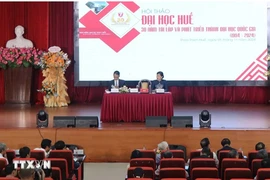If Tower Bridge with neo-Gothic architecture is considered a symbol of the misty London capital, Golden Gate Bridge is known as the gateway on the road from the Pacific Ocean to San Francisco Bay, or when talking about Nanpu Bridge, people would immediately think about the bustling city of Shanghai; then perhaps, referring to Hanoi, people would think of not only Long Bien Bridge - a witness of history, but also a long story about bridges crossing the Red River that connect traffic, economic and cultural arteries of the thousand-year-civilized capital.
As the first steel bridge crossing the Red River, Long Bien Bridge was built by the French from 1898 to 1902 under the Governor-General of Indochina.
After 119 years of witnessing many ups and downs and historical events, the bridge is still proudly standing there and is still an indispensable part of connecting the traffic of Northern provinces to Hanoi.
With a length of 2290m across the river and 896m of bridge approaches, Long Bien Bridge consists of 19 steel beam spans placed on 20 pillars with unique architecture. This bridge was once the second-longest bridge in the world and was even called the Eiffel tower that lied horizontally across the gate of Hanoi. The bridge is designed with a single rail track in the middle and two lanes on both sides for pedestrians and motor vehicles. Currently, although there are many other bridges serving traffic, people still like to be nostalgic at Long Bien Bridge, both to contemplate a work that bears historical imprints and to let their souls relax in the middle of a poetic scenery of the green alluvial plain shaving their banks hidden and revealed by the tides of the Red River.
Located about 5km north of Long Bien Bridge, Thang Long Bridge is the second bridge built across the Red River, carrying strong Viet Nam-Soviet Union friendship. The bridge was inaugurated in 1985 after 11 years of construction with many events happening. With a total length of about 10.7km, Thang Long Bridge is designed with two floors: the upper floor is for cars, and the lower is for motor vehicles and trains. Thang Long Bridge is important in connecting the traffic between the capital and Noi Bai International Airport.
In the 80s of the last century, when the traffic of Hanoi city center was concentrated on Long Bien Bridge, people thought of building a new bridge to meet the commuting demand. So, Chuong Duong Bridge was inaugurated and put into use only after 21 months of rapid construction. This is the first steel-concrete bridge completely designed and built by Vietnamese engineers and workers without any technical assistance from foreigners. The bridge has a length of 1230m with 11 steel spans and 10 concrete spans with four lanes for two-way traffic; an additional roundabout system was built on the southern end of the bridge in the late 90s to help solve congestion at the up-and-down entrance. Currently, the bridge is still persistently serving the capital's traffic with a large frequency when the number of vehicles is increasingly proportional to the development of society.
In order to relieve the traffic burden for the bridges of the last century, two new bridges that were built next were Vinh Tuy and Thanh Tri - both inaugurated in 2010. Both are responsible for connecting traffic between new urban areas and industrial zones in the Long Bien and Gia Lam districts, and the area at the Eastern gateway of Hanoi. Vinh Tuy Bridge is constructed to mark the 1000th anniversary of Thang Long-Hanoi, while Thanh Tri Bridge on its inauguration used to be the largest pre-stressed reinforced concrete bridge in Vietnam with many technological applications. It can be said that Thanh Tri Bridge has successfully completed the task of connecting National Highway 1 and National Highway 5, creating favorable conditions for Hanoi's trade with key economic provinces in the Northern region.
Up to now, the latest bridge that has been completed and put into use across the Red River is Nhat Tan Bridge - a modern cable-stayed bridge, a symbol of the friendship between Vietnam and Japan. Inaugurated in 2015 after six years of construction, Nhat Tan Bridge, located between Long Bien Bridge and Thang Long Bridge, is one of the few continuous multi-span cable-stayed bridges in the world. With a prime location that is important in connecting the central area of Hanoi with the new highway to Noi Bai International Airport and northern industrial zones, Nhat Tan Bridge carries many modern technologies that were first applied in Vietnam such as a monitoring system to measure the tension of the stayed cables and the stress of the reinforcement, or the steel pipe pile encirclement structure. In particular, when night falls, the bridge puts on a magical shimmering beauty when illuminated with modern technology - flexible color-changing effects following daily or seasonal induction.
After 67 years the since Hanoi was completely liberated, the capital has gradually transformed, reaching comprehensive development in terms of politics, economy, culture, and society. That development is not only associated with monumental construction works and unceasingly-enhanced material and spiritual life of the people, but also with renovation and upgrading of infrastructure and transportation.
This is prominently shown in the bridges, which are sequentially erected across the Red River linking the lifeblood of the city as well as other localities. Soon, new bridges will continue to be built, not only to help solve traffic problems in Hanoi but also to mark new steps in the development of the thousand-year-civilized capital./.



















